
Cardo Decumanus Crossing was in the heart of Roman Berytus (actual Beirut, Lebanon).

Cardo Decumanus Crossing was in the heart of Roman Berytus (actual Beirut, Lebanon).
The Cardo and Decumanus Maximus were the main colonnaded streets of Roman Berytus.
Today, five erected columns mark the crossing of the Cardo and the Decumanus Maximus, the two main colonnaded streets of Roman Berytus. The Cardo Maximus connected the Roman Forum to a large complex, extending from the al-Azariyeh building to Riad Al Solh Square. [1] The Decumanus Maximus ran perpendicular to Emir Bashir Street. Salvaged material from these colonnaded streets was used since the Umayyad period to build a new city wall and a water reservoir near the Roman crossing.
The construction of the ring road in 1860 and building projects of the 20th century eliminated most of the ancient features. The new entrance to the Garden of Forgiveness gives access to the original Roman street.
The Cardo Maximus connected the Roman Forum to a large complex, that was the center of the old Roman city. The Decumanus Maximus ran parallel to Emir Bashir Street, following the line of the earlier Romano-Hellenistic city wall.
The site of the crossing and the stairway next to it were once known as ‘the stairway of the forty martyrs’, commemorating the story of forty Christians martyred during Roman persecutions. The stairway led from Emir Bashir Street to the pre-war food markets or souks: al-Lahhamin (the meat market), as-Samak (the fish market), al-Bayd (the egg market) and Al-Khodra (the vegetable market).
The construction of the ring road in 1860, connecting the Damascus-Beirut road to the harbor, and later building projects of the 20th century have obliterated most of the ancient features. The new entrance to the Garden of Forgiveness gives access to the original Roman street.

Aelia Capitolina was a Roman colony founded during Emperor Hadrian's visit to Judaea in 129/130 AD, centered around Jerusalem, which had been almost totally razed after the siege of 70 AD.

Beirut is the capital and largest city of Lebanon. As of 2014, Greater Beirut has a population of 2.5 million, which makes it the third-largest city in the Levant region and the thirteenth-largest in the Arab world. The city is situated on a peninsula at the midpoint of Lebanon's Mediterranean coast. Beirut has been inhabited for more than 5,000 years, making it one of the oldest cities in the world.
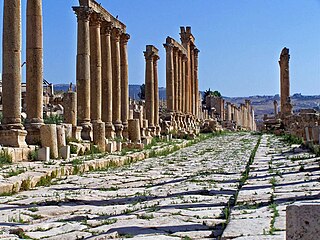
A cardo was a north–south street in Ancient Roman cities and military camps as an integral component of city planning. The cardo maximus, or most often the cardo, was the main or central north–south-oriented street.

Timgad was a Roman city in the Aurès Mountains of Algeria. It was founded by the Roman Emperor Trajan around 100 CE. The full name of the city was Colonia Marciana Ulpia Traiana Thamugadi. Emperor Trajan named the city in commemoration of his mother Marcia, eldest sister Ulpia Marciana, and father Marcus Ulpius Traianus.

Antioch in Pisidia – alternatively Antiochia in Pisidia or Pisidian Antioch and in Roman Empire, Latin: Antiochia Caesareia or Antiochia Colonia Caesarea – was a city in the Turkish Lakes Region, which was at the crossroads of the Mediterranean, Aegean and Central Anatolian regions, and formerly on the border of Pisidia and Phrygia, hence also known as Antiochia in Phrygia. The site lies approximately 1 km northeast of Yalvaç, the modern town of Isparta Province. The city was on a hill with its highest point of 1236 m in the north.
A forum was a public square in a Roman municipium, or any civitas, reserved primarily for the vending of goods; i.e., a marketplace, along with the buildings used for shops and the stoas used for open stalls. Many fora were constructed at remote locations along a road by the magistrate responsible for the road, in which case the forum was the only settlement at the site and had its own name, such as Forum Popili or Forum Livi.
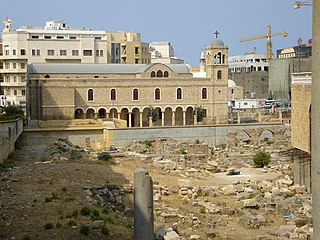
Berytus, briefly known as Laodicea in Phoenicia or Laodicea in Canaan from the 2nd century to 64 BCE, was the ancient city of Beirut from the Roman Republic through the Roman Empire and Early Byzantine period/late antiquity. Berytus became a Roman colonia that would be the center of Roman presence in the eastern Mediterranean shores south of Anatolia. The veterans of two Roman legions under Augustus were established in the city, that afterward quickly became Romanized and was the only fully Latin-speaking city in the Syria-Phoenicia region until the fourth century. Although Berytus was still an important city after earthquakes, around 400 CE Tyre was made the capital of the Roman province of Phoenicia. "Of the great law schools of Rome, Constantinople, and Berytus", the law school of Berytus stood "pre-eminent". The Code of Justinian was mostly created in this school.
The Garden of Forgiveness is a garden in Beirut, close to Martyrs’ Square and the wartime Green Line (1975-1990).
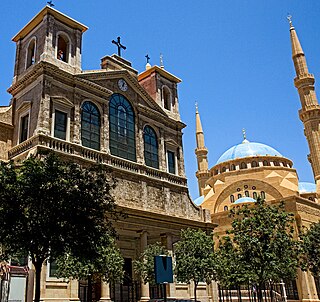
The tourism industry in Lebanon has been important to the local economy historically and to this day comprises a major source of revenue for the country.

A tetrapylon is a rectangular form of monument with arched passages in two directions, at right angles, generally built on a crossroads. They appear in ancient Roman architecture, usually as a form of the Roman triumphal arch at significant crossroads or geographical "focal points".

In Roman urban planning, a decumanus was an east–west-oriented road in a Roman city or castrum. The main decumanus of a particular city was the decumanus maximus, or most often simply "the decumanus". In the rectangular street grid of the typical Roman city plan, the decumanus was crossed by the perpendicular cardo, a north–south street.

Saint George Maronite Cathedral is the cathedral of the Maronite Catholic Archeparchy of Beirut, Archdiocese of the city of Beirut, Lebanon. Its construction, with a Neoclassical facade, interior and plan inspired by the Basilica di Santa Maria Maggiore, began in 1884 and ended in 1894.
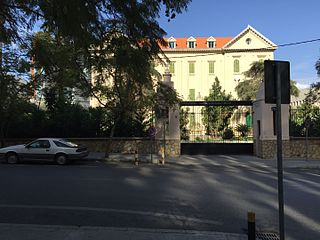
Badaro is a residential neighborhood and business hub in the heart of Beirut, Lebanon. The neighborhood is roughly bounded by the Pierre Gemayel avenue on the north, the Hippodrome on the west, Sami el Solh avenue on the east, Beirut's pine forest on the southeast, and the Tayyouneh roundabout on the south. Badaro is the common name of Beirut's "Horsh" (park) administrative district, which also includes three parks: a75 acres (30 ha) pine forest known as Horsh Beirut, the Beirut Hippodrome and the Pine Residence, the French ambassador's residence.

The Great Colonnade at Apamea was the main colonnaded avenue of the ancient city of Apamea in the Orontes River valley in northwestern Syria. It was built in the second century CE after Apamea's devastation in the 115 earthquake. The avenue, which runs for nearly 2 kilometres (1.2 mi), made up the city's north-south axis, or the cardo maximus. The monumental colonnade is among the longest and most famous in the Roman world.
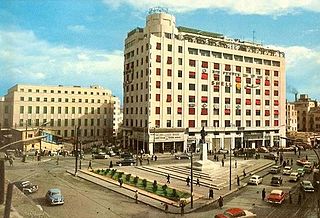
Riad Al Solh Square is a square in the heart of downtown Beirut, Lebanon.
Emir Munzer Mosque is a mosque located in Beirut Central District, Lebanon.

The Roman Forum is located in Beirut, Lebanon.

Colonnaded Street is located in downtown Beirut, Lebanon. it was an important street of Roman-era Berytus.
The Beirut Heritage Trail is a project undertaken by Solidere with the support of the Ministry of Culture and the Municipality of Beirut. Marked out by bronze medallions grouted into the sidewalk, the trail will link archeological sites, historic public spaces and heritage buildings over a 2.5 km walking circuit in the historic core of Beirut.

The Roman forum of Philippopolis is a rectangular forum (plaza) surrounded by the ruins of several ancient administrative buildings at the center of the ancient city of Philippopolis. It was the center of public, administrative, commercial and religious life in the ancient city. Meetings, discussions, celebrations and state events were held there.